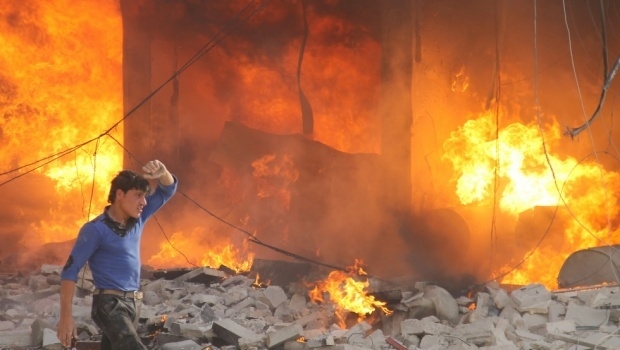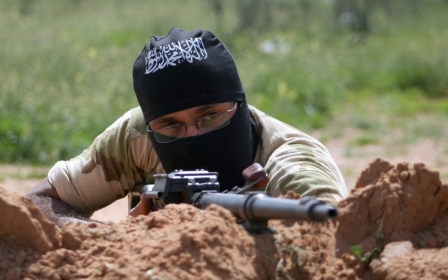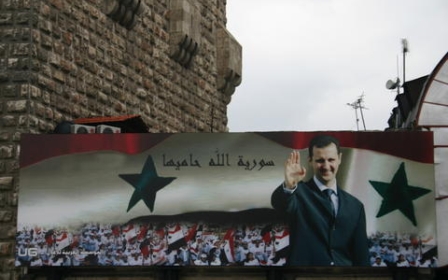Blood on both sides in Syria

As the conflict in Syria enters its fourth year, international press reports focus on the human rights violations of President Bashar al-Assad’s government. However, the war crimes of the insurgent forces have been kept away from the spotlight, mainly for political reasons.
Since the Obama administration imposed sanctions on 29 April 2011 on some Syrian officials reportedly accused of using violence against civilians, the US, European and regional sponsors of a “regime change” in the country have so far held the Syrian government as the only party responsible for violence against civilians. Consequently, the UN and Western international human-rights organisations have followed suit.
This concealment of the insurgents’ responsibility serves a purpose – it ensured their sponsors’ impunity - they could continue to back the rebels, knowing that they would not be held accountable for their crimes.
The sponsors’ reluctance to arm the Syrian rebels with advanced weapons lest they fall into the hands of the terrorist organisations could not hide their initial and ongoing arming and recruitment efforts, which empowered the militarisation of the peaceful civilian protests with its most extreme Syrian and non-Syrian insurgents.
On 8 April, Navi Pillay, the UN High Commissioner for Human Rights, addressing the UN security council, stated that the actions of the Syrian government "far outweigh" the crimes by the “opposition” fighters.
New MEE newsletter: Jerusalem Dispatch
Sign up to get the latest insights and analysis on Israel-Palestine, alongside Turkey Unpacked and other MEE newsletters
However, close scrutiny of the death toll statistics and the facts of the humanitarian fallout of the conflict tell a different story.
On 1 April this year, the UK-based Syrian Observatory for Human Rights (SOHR) said it had documented at least 150,000 deaths in the conflict: more than 58,000 of them were government troops and some 38,000 rebels; the rest were civilians, many of whom were victims of suicide bombings and mortar shells fired by the rebels.
Contrary to Pillay’s conclusion, the breakdown of these figures show the government as more of a victim than a culprit, and indicate that the actions of the rebels “far outweigh” those of the government.
On 28 February 2012, in an article entitled Questioning the Syrian ‘Casualty List’ in the Lebanese newspaper Al Akhbar, political analyst Sharmine Narwani states that: “The very first incident of casualties from the Syrian regular army that I could verify dates to 10 April 2011, when gunmen shot up a bus of soldiers travelling through Banyas, in Tartous, killing nine.” This was a few weeks after the first peaceful protests broke out in Syria, a fact which questions the now wrongfully accepted view that the government was the party that initiated the “violence”.
Political motives
The communique issued by the 11 Western and Arab foreign ministers of the core group of the so-called “Friends of Syria” after their meeting in London on 15 May was the latest example of the political motives behind the media blackout of the insurgents’ responsibility for the conflict.
They called the upcoming presidential elections on 3 June “illegitimate” and a “parody of democracy”. ignoring the fact that any power vacuum in Syria would only create the right environment for the collapse of the central government.
The inevitable result would be an exacerbation of the humanitarian crisis in the country, rendering their humanitarian rhetoric a parody of humanity.
Worse still, the 11 “Friends of Syria” have “agreed unanimously” to boost their support to what they described as “the moderate opposition National Coalition (SNC), its Supreme Military Council and associated moderate armed groups”.
What “moderates” do they refer to? On 25 September last year, the BBC quoted a recent study published by IHS Jane's analyst Charles Lister, which concluded that, “the core of the Syrian insurgency is composed of Islamist groups of one kind or another”.
Three years and three months on, the “Friends of Syria” have failed to bring the “regime” down. On the contrary, it has got the military upper hand, while the organisations that the US and Saudi Arabia list as terrorists hold sway in the rebel-held areas.
Whatever military supplies the “moderate” rebels could get will only prolong the war, postpone any political settlement, and perpetuate and exacerbate the worsening humanitarian crisis.
Civilian protesters, political opposition and “secular” armed rebels were hijacked, sidelined and finally dumped by the mainstream rebel forces, whose backbone consists of “foreign fighters”, thus dooming any political solution for a long time to come and vindicating al-Assad’s statement that, “No solution can be reached with terror except by striking it with an iron fist.”
No justification for abuses
As early as March 2012, Sara Leah Whitson, Middle East director at Human Rights Watch, warned that, “The Syrian government’s brutal tactics cannot justify abuses by armed opposition groups.”
Schools, universities, hospitals, health clinics, churches, mosques, religious monuments, power grids, railways, bridges, oil fields, historical sites, museum assets, symbols of public safety and order, and other infrastructure have all been targeted by the rebels in an unprecedented wave of destruction.
A survey, conducted by the UN’s Relief and Works Agency and released early last April, stated that it would take 30 years for the Syrian economy to recover to its 2010 level.
According to the SOHR, the infighting among rebels has claimed more than 5,000 casualties in 2014. Meanwhile, the infighting over border crossings and oil fields displaced more than 100,000 civilians in north eastern Syria during the past month.
Since the very beginning, the rebels have been using Syrian civilians as a bargaining chip and as human shields, a fact which the “Friends of Syria” have been keen to blackout.
On 12 May, rebels agreed to free 1,500 families whom they had kidnapped and held hostages in Adra, a suburb of the capital Damascus, for the release of rebels jailed by the government. Two weeks ago they freed some one hundred infants, children and elderly men and women, in exchange for evacuating the Old City of Homs unharmed.
On 4 May, they cut off the water supply to some three million civilians in Syria’s second largest city of Aleppo, a collective punishment reminiscent of a similar horrible practice by Israel in Beirut in 1982. Last month, the rebels cut off the electricity supply. And for the past two years they have been bombarding the western side of the city, which is under government control, with mortar shells from the rebel-controlled eastern side, and turning the civilian life there into a nightmare of suicide and tunnel bombings.
High civilian price
These inhuman tactics are not the exception, but the norm and rule. Since the very beginning of the rebellion in March 2011, rebels stormed into Syrian city centres, where there was no official military presence, and used the civilian population as human shields against any retaliation by the government forces, thus unleashing what the UN described as the world’s largest refugee problem.
Civilians have paid a high price. Syrians now hold the rebels responsible for their plight. Their sectarian public incubator has already turned against them in favour of restoring the missing safety, security and order by the government.
All factions of the rebels claim that they are the representatives of the Muslim Sunni majority, but the overwhelming majority of some six million Syrians who are displaced internally are Sunnis. These have now found refuge with non-Sunni compatriots in safe havens under government protection. Plus there are more than three million refugees, the majority Sunni Syrians who have fled to neighbouring countries from the areas held by the rebels.
Friends of Syria?
It’s a well-known fact that by creating a humanitarian crisis in Syria, whether real or fabricated, and holding the Syrian government responsible for it as a casus belli for foreign military intervention under the UN 2005 so-called "responsibility to protect" initiative, was from the very beginning the goal of the US-led so-called "Friends of Syria” coalition.
A second fact was the rush to militarise the Syrian civilian peaceful protests. When Assad issued in 2011 the first of his six general amnesties, former US secretary of state Hillary Clinton went on record with a public appeal to armed rebels not to lay down their arms in response.
In March 2014, a commission of inquiry mandated by the UN Human Rights Council, chaired by Paulo Pinheiro, accused the insurgents in Syria for the first time of “crimes against humanity” and “war crimes”.
On 14 May, Syrian Rev. Michael Rabaheih, from the Greek Orthodox church, was quoted by the Washington Post as saying: “If this is freedom, we don’t need it.”
The “Friends of Syria” have failed to artificially create any credible alternative to the incumbent regime, and the only losers in this seemingly intractable war are the Syrian people.
Nicola Nasser is a veteran Arab journalist based in Birzeit, West Bank of the Israeli-occupied Palestinian territories.
The views expressed in this article belong to the author and do not necessarily reflect the editorial policy of Middle East Eye.
Photo credit: A man walks past a burning building following a reported air strike by pro-regime forces in Aleppo (AFP)
Middle East Eye delivers independent and unrivalled coverage and analysis of the Middle East, North Africa and beyond. To learn more about republishing this content and the associated fees, please fill out this form. More about MEE can be found here.





